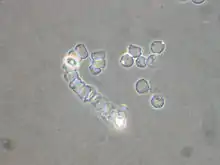| Acrasid slime molds | |
|---|---|
 | |
| Acrasis rosea | |
| Scientific classification | |
| Domain: | Eukaryota |
| Clade: | Discoba |
| Superphylum: | Discicristata |
| Phylum: | Percolozoa |
| Class: | Heterolobosea |
| Order: | Acrasida |
| Family: | Acrasidae van Tieghem 1880 ex Hartog 1906 |
| Genera | |
| |
| Synonyms | |
| |

The family Acrasidae (ICZN, or Acrasiomycota, ICBN) is a family[1] of slime molds which belongs to the excavate group Percolozoa. The name element acrasio- comes from the Greek akrasia, meaning "acting against one's judgement". This group consists of cellular slime molds.
The terms "Acrasiomycota" or "Acrasiomycetes" have been used when the group was classified as a fungus ("-mycota"). In some classifications, Dictyostelium was placed in Acrasiomycetes, an artificial group of cellular slime molds, which was characterized by the aggregation of individual amoebae into a multicellular fruiting body, making it an important factor that related the acrasids to the dictyostelids.[2]
Reproduction
When resources such as water or food become limiting, the amoeba will release pheromones such as acrasin to aggregate amoebal cells in preparation for movement as a large (thousands of cells) grex or pseudopod. When in the grex, the amoeboids reproduce, resulting in fruit-like structures called spores, which develop into unicellular molds of the same species.
References
- ↑ Roger AJ, Smith MW, Doolittle RF, Doolittle WF (1996). "Evidence for the Heterolobosea from phylogenetic analysis of genes encoding glyceraldehyde-3-phosphate dehydrogenase" (PDF). J. Eukaryot. Microbiol. 43 (6): 475–85. doi:10.1111/j.1550-7408.1996.tb04507.x. PMID 8976605.
- ↑ Cavender J.C.; Spiegl F.; Swanson A. (2002). "Taxonomy, slime molds, and the questions we ask". The Mycological Society of America. 94 (6): 968–979. PMID 21156570.
Further reading
- C.J. Alexopolous, Charles W. Mims, M. Blackwell et al., Introductory Mycology, 4th ed. (John Wiley and Sons, Hoboken NJ, 2004) ISBN 0-471-52229-5